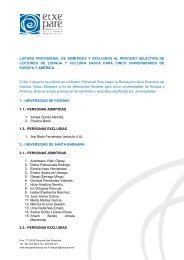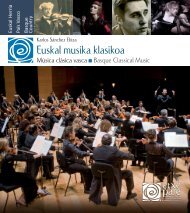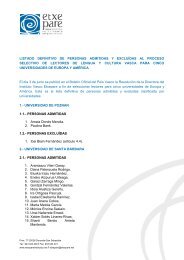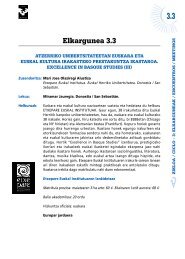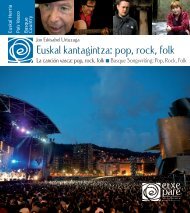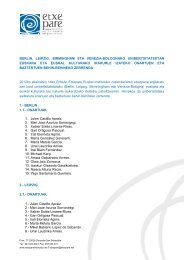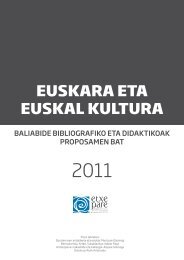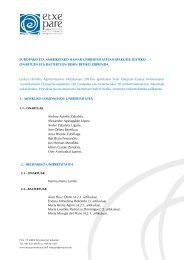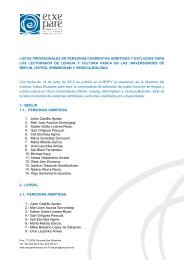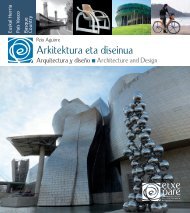Euskal dantza - Etxepare, Euskal Institutua
Euskal dantza - Etxepare, Euskal Institutua
Euskal dantza - Etxepare, Euskal Institutua
You also want an ePaper? Increase the reach of your titles
YUMPU automatically turns print PDFs into web optimized ePapers that Google loves.
Miguel y Cristo, representadas por fieles se abrenpaso con los sonidos del chistu y las castañuelas percudasde los bailarines del grupo Oñatz. Interpretancon solemnidad y precisión un bello conjunto dedanzas que han perdurado en estrecha relación conel Corpus Chris: San Sebasan, banako, launako,zortziko y arku-<strong>dantza</strong>. Y, para acabar el día, el aurreskuo soka-<strong>dantza</strong>.La celebración del Corpus Chris o Besta Berri se hamantenido con gran fuerza en el interior de Laburdiy en algunos pueblos de la Baja Navarra. Con la eleganciade las marchas militares y ceremoniales, la coloridacomparsa de la Besta Berri de Heleta es dignade ver. Los zapurrak, oilarrak, sarjentak, kaporalak,alabardariak y banderariak ofrecen un bello ceremonialmarcando la marcha que avanzado seis pasos yretrocediendo cuatro cada vez entra lentamente enla iglesia.Danzas de espadas (Ezpata-<strong>dantza</strong>k)El 3 de mayo, día de la Santa Cruz y día grande de lasfiestas locales, la ezpata-<strong>dantza</strong> concentra la atenciónde los habitantes de Legazpi. Comienza el esofesvo, plagado de danzas de espadas, que connuaráen las semanas siguientes con ezpata-<strong>dantza</strong>s enSan Sebasán, Zumárraga, Tolosa, Markina-Xemein,Deba, Lesaka y Bera entre otros. Junto a las citadas,en los úlmos años varias localidades han recuperadoy recreado sus propias danzas de espadas, demodo que hoy en día también se baila la ezpata<strong>dantza</strong>en Elgoibar, Eibar, Beasain, Pamplona, Añorgay Andoain.Estos ezpata-<strong>dantza</strong>ris usan espadas, pero no paraluchar entre sí. Estas danzas de espadas son de eslohilt and point o “empuñadura y punta”, conocido enmuchas otras regiones de Europa. En esta modalidad,cada bailarín coge una espada por la empuñaduray otra por la punta. De esa manera, los bailarinesconstruyen una cadena unidos por las espadas.Se les conoce como ezpata-<strong>dantza</strong>riak (bailarín deEzpata-<strong>dantza</strong>kOn 3 May, Santa Krutz day (the day of the cross) andthe main day of the local fesval in Legazpi, locals’aenon turns to the ezpata-<strong>dantza</strong>k. This is thebeginning of the ezpata-<strong>dantza</strong> season, and in theweeks that follow several towns will celebrate theirown ezpata-<strong>dantza</strong>k: Donosa-San Sebasán, Zumarraga,Tolosa, Markina-Xemein, Deba, Lesaka andBera. In recent years, people have started to performthe ezpata-<strong>dantza</strong>k in several other towns, copyingthe structure already noted. As a result, the ezpata<strong>dantza</strong>kare today also performed in Elgoibar, Eibar,Beasain, Iruñea-Pamplona, Añorga and Andoain.The dancers carry swords but not in order to fightwith each other. Instead, they perform a kind of “hiltand point” dance that is typical in many regions ofWestern Europe. This means that each dancer takesone sword by the hilt and another by the point.That way, the dancers make up a chain composedof the sword ps coming together. Most of these areknown by the term ezpata-<strong>dantza</strong>k although someof them do not even use real swords. In Deba andLesaka, for example, they use scks decorated withcolourful ribbons; in Tolosa they use pikes and inBera ropes.The swords are usually over a metre long. In Euskara,they are called bi eskuko ezpatak (two-handedswords) because two hands are needed to use themdue to their size and weight. The group is joined togetherby these swords, arranged into two or fourrows with a leader in front binding all the rows together.The group moves according to the instruc-ons of a leader, dance-master, guide or old teacher,and the swords make several choreographic figureswithout coming undone from one another. Then, inorder to form a bridge, the leader makes a half turnand goes backwards, taking with him the dancers atthe front with their swords held alo and passingover the remaining dancers. Those that follow frombehind do the same thing, unl the whole group has31



